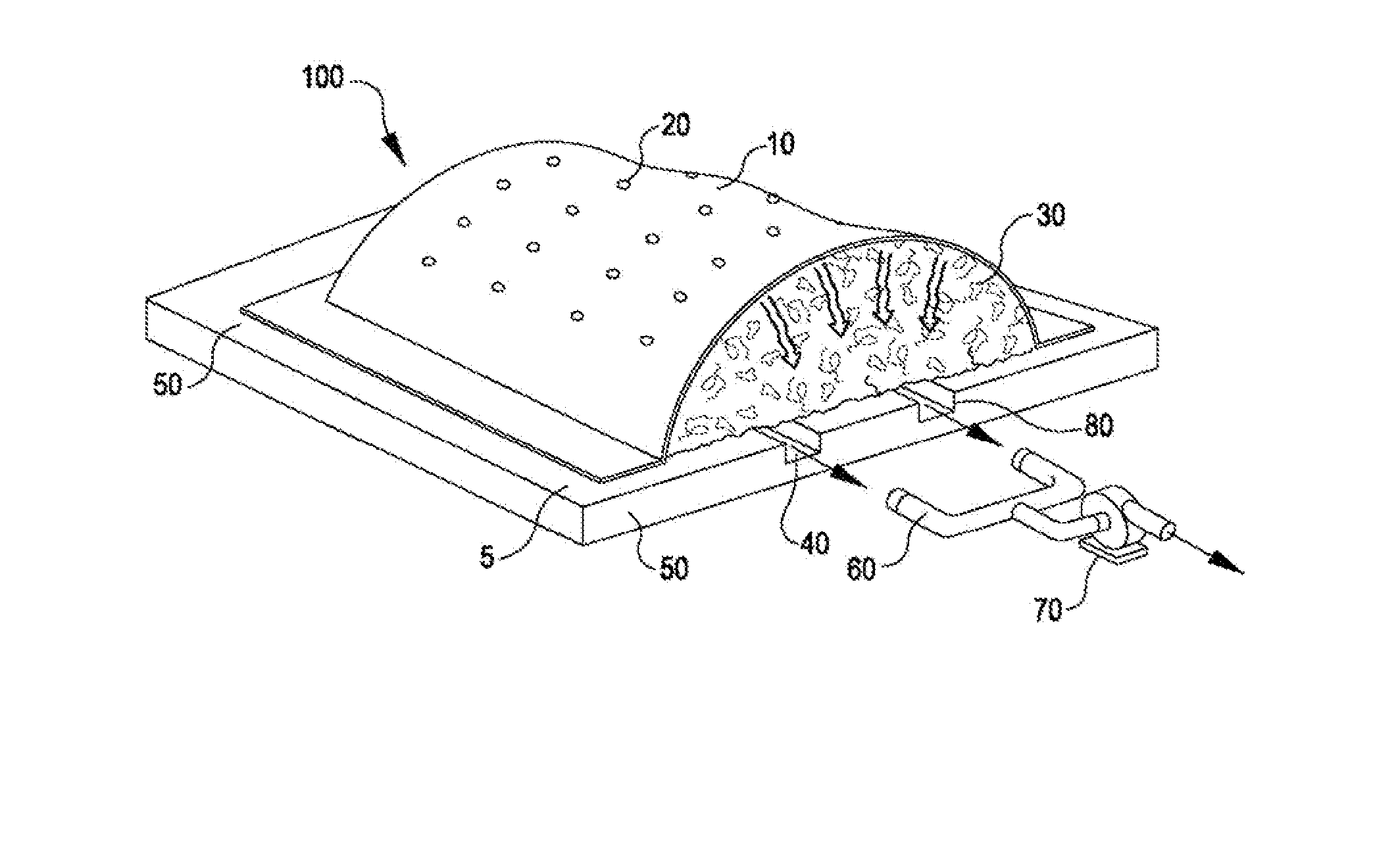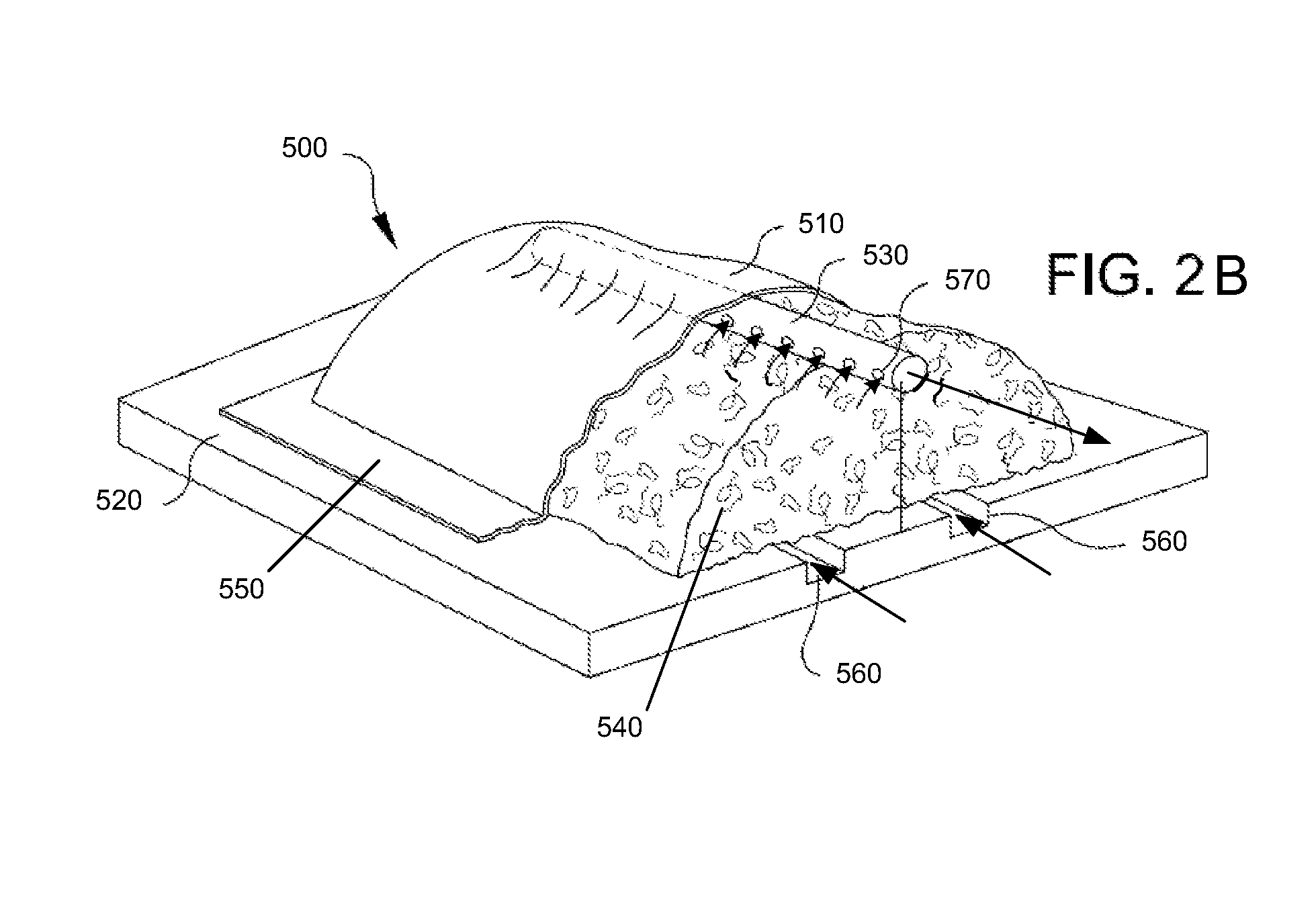[0012] Systems and methods for generating compost utilizing aeration are provided. The systems disclosed herein are capable of controlling compost odors, maintaining the desired
oxygen levels in the biomass, and minimizing evaporative
drying of the biomass. The disclosed systems and methods for generating compost may utilize negative or positive aeration.
[0014] The compost cover is formed of a material that is substantially gas and liquid impermeable, and is provided a plurality of aeration ports, or orifices, that permit the passage of gases through the cover. The size and number of aeration ports may be varied to meet the air-flow requirements for given biomass, or feed stocks,
zone size and process goals. The compost cover is generally constructed of fabric that is durable, flexible, UV resistant, waterproof, and relatively light-weight.
[0015] The aeration floor may be constructed of concrete or the like, and has a generally flat, planar working surface. The surface of the aeration floor is provided with a plurality of gas flow apertures, or orifices, that connect to at least one gas flow
pipe, or channel, installed below grade. In certain embodiments, a network of gas flow pipes and / or channels is provided. An air suction manifold is sealably and removably connected to at least one outlet of the network of gas flow channels and / or pipes, providing air removal from the compost biomass. The air suction manifold draws air and / or other gases downwards from the bottom area of the biomass, through the plurality of gas flow apertures in the aeration floor, and into the network of gas flow channels and / or pipes. The
air travels through the network of channels and / or pipes and is conveyed towards the outlet. The air then passes through the air suction manifold to an air
distributor that is sealably and removably connected to the air suction manifold. Through the air
distributor, the air from the compost biomass is distributed towards a
discharge manifold that directs the air towards an
odor control device, such as a
biofilter, where the air is treated to substantially eliminate compost odors.
[0020] In other embodiments, positive aeration composting systems are provided. In one such embodiment, the composting system comprises a compost cover, a positively aerated floor, and a suction system positioned in proximity to, or associated with, the compost cover and located near a top of a biomass pile.
Biomass for use in generating compost is placed on the positively aerated floor, and the compost cover is placed over the biomass. The edges of the compost cover, which substantially covers the biomass, may be weighted and / or connected to the positively aerated floor by way of
strapping means connected to fastening points in the positively aerated floor, in order to provide a loose seal to the positively aerated floor. During operation, air flow drawn by the suction system at the top of the biomass pile maintains a negative pressure across the compost cover, thereby generating suction between the compost cover and the top of the compost biomass pile. The suction causes the compost cover to be substantially sealed onto the top of the compost biomass pile, preventing release of gasses from the biomass to the
atmosphere.
[0021] In one embodiment, the compost cover is formed of a material that is substantially gas and liquid impermeable. In another embodiment, the compost cover is formed of a material that is semi-permeable. The compost cover is generally constructed of fabric that is flexible, durable, UV resistant, waterproof, and relatively light-weight.
[0026] The aeration vault may be left open at one or both ends whereby air can flow freely through the aeration vault via the open ends, allowing the compost biomass pile to be aerated. Alternatively, the one end of the aeration vault may be connected to a
forced air aeration system, allowing induced aeration to take place within the negative or positive aeration composting system, wherein desirable
oxygen and temperature levels of the compost biomass pile can be controlled and maintained, and the production of compost odors can be substantially eliminated.
 Login to View More
Login to View More  Login to View More
Login to View More 


